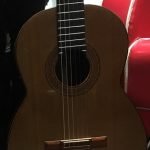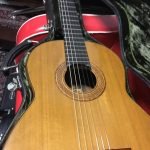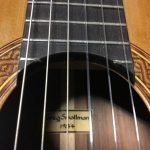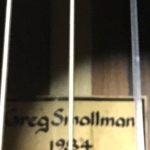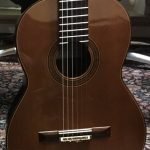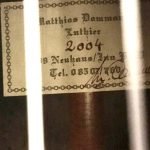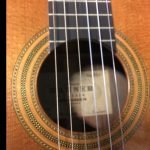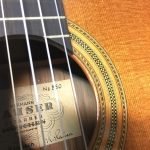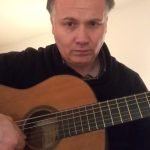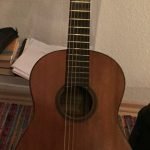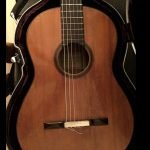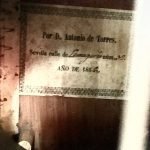INTRODUCTION
As far as TIMBRE richness and frequency range are concerned, the classical concert guitar, as a polyphonic instrument (like the piano), should be able to harmonically simulate a “small orchestra”... This is how its great interpreter, Maestro Segovia, defined it.
THE ACOUSTIC LIMITATIONS OF THE GUITAR
The main limitations of the classical guitar are listed below:
- Very limited bandwidth (frequency response) (about 85hz-987hz) in traditional guitars (from Torres to Hauser I) and quite often even more limited in contemporary ones (about 110hz-987hz)
- Extremely irregular frequency response (TIMBRE UNBALANCE): within a given bandwidth, it exhibits a behaviour characterized by peaks and troughs at certain frequencies
- Limited power
What we mean by limited “frequency response”:
Se If we compare the frequency range emitted (bandwidth “covered”) by our polyphonic instrument (the classical guitar) with that of the other, more famous polyphonic musical instruments, namely the piano, or with the set of string instruments, we observe that it is much more limited than these:
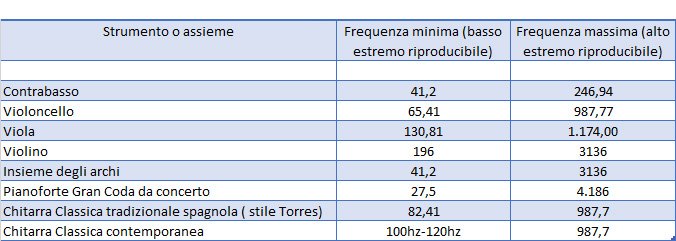
there is table 1.a
A problem with timbre unbalance
Within its various resonance frequencies the guitar has, some frequencies at which the sound box does not resonate. In the frequency domain it generates a troubled and irregular response, characterized by peaks (corresponding to the frequencies at which the sound box resonates) and troughs (corresponding to the frequencies at which the sound box does not resonate).
The consequence of this is that all string instruments which use box resonance as their main resource for sound production (string instruments, mandolin, lute, piano, etc. etc.) are beset by some notes that sound significantly louder than others.
Limited sound power:
As ascertained during our tests on both historical guitars (de Torres and Hauser project), as well as on the main contemporary projects (“latex bracing” with carbon-reinforced chaining; project with “Double-Top” board with Kevlar), tests conducted by us to measure the SPL of these instruments (sound pressure level = maximum power delivered by our instrument), have highlighted the fact that the classical guitars under test (examples of the most renowned construction projects of today and of the past), always presented, in terms of SPL, a detection made at a distance of about 3.7 meters from the instrument being detected, values ranging from 83db to 83.6db (this data also shows us that, from a certain distance, the constructive innovations introduced to date have not brought significant improvements to this issue of limited sound power and acoustic projection).
Just for reference’s sake: at the same distance (3.7 meters) a violin has an SPL of 88db; viola = 88db; cello and double bass about 86 db; oboe about 86db, harp about 88 db; bassoon about 88 db.
Here is a summary table:
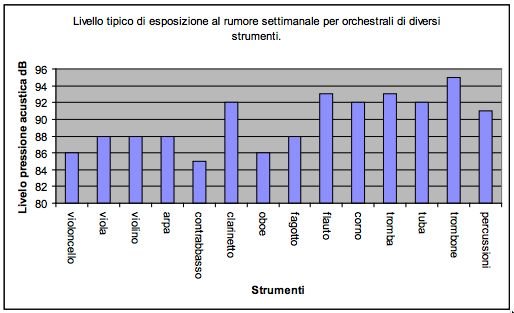
So all instruments, or the vast majority of them, have an average of +4db to +7db more than the classical guitar (at a distance of about 3.7 meters). If we consider that +3db are perceived by our ear as a doubling of volume, the limitation in terms of acoustic power of the classical guitar, when compared to other instruments, is clear.
This limitation in sound power also creates a certain criticality when playing classical guitar with different ensembles.
From the results obtained in these tests we will see how the Sellitto project guitar compares with the foremost historical projects (Torres and Hauser) as well as the contemporary ones (lattice bracing project and double top project).
For ease of understanding (regarding the main acoustic limits mentioned above) these results are briefly reported hereunder once again:
CLASSICAL GUITAR PROJECTS COVERED BY OUR BENCHMARKING TEST
We used the two methodologies that seemed to us the most objective and viable, thus clearing the results from what could be the intervention of the human factor (represented by the guitarist) which in some way could alter the results of the tests:
1) We placed the instrument under test on an electro-mechanized bench, binding it in place by means of small foam rubber supports, placed at nonvibratory points on the instrument.
The machine that simulated the right hand (so as to always have the same input for all instruments) was equipped with an electric motor induction to which was connected a plectrum made of harmonic steel: the string was plucked by the mechanical arm with an inclination of 60° with respect to the soundboard and with a force equal to 0,68 Newton (for the test of the levels of the single strings, plucked empty, to evaluate the balance) and 0,87 Newton for the test of the SPL (sound pressure level =maximum sound pressure produced) of the instruments playing the series of open strings continuously
2) Cymatics tests (described below) to assess the timbre quality and frequency extension of the instruments being tested: our research has shown that the modal form determines the efficiency and qualitative characteristics of the radiation.
Why vibrational analysis? :
Our soundboard resonates at particular frequencies, as a function of the characteristics of the wood, the chaining implemented, which tunes the soundboard permanently, thus determining the number and vibrational modes.
Analyzing the results of more than 800 tests, it was possible to confirm the absolute validity and completeness of Chladni’s method for determining the quality of a musical instrument, which over the years has become the international standard by which scholars and luthiers analyze musical instruments.
For the cymatic analysis we used instead the following equipment:
· Acoustic box we designed and built, in air suspension, capable of emitting frequencies from 20hz
· Custom loudspeaker, built by an Italian manufacturer on our specifications, which can emit frequencies from 20 hz to 4 khz
· Sinusoidal function generator
· NAD3020E amplifier to which our function generator has been connected as a signal source, and our acoustic box as an output.
CLASSICAL GUITAR PROJECTS COVERED BY OUR BENCHMARKING TEST
From the results obtained in these tests we will see how the Sellitto
project guitar compares with the foremost historical projects (Torres and
Hauser)ell as the contemporary ones (lattice bracing project and double
top project).
Guitars that are summarized and listed below:
Guitar 1 : Lattice Bracing Project
Guitar 2 : Double Top Project
Guitar 3 : Hauser Project
Guitar 4 : Torres Project with Tornavoz
Guitar5 : Sellitto ProjectSellitto
Conditions and equipment used
:
1. Room temperature: 25°C
2. Relative humidity: 55%
3. Acoustically designed room (similar to an anechoic chamber); room size: 9.30 meters x 7.50 meters x 3.10 meters
metri
4. Colemeter sound level meter positioned 1 meter away from the instrument
strumento
5. Colemeter sound level meter directed at a point 175 mm away from the bridge in the direction of the fingerboard
6. String plucked at a distance of 135 mm from the bridge in the direction of the fingerboard
7. With a force of 0.68 Newton
8. With a 60° inclination to the harmonic soundboard.
Description of Test 1:
IThe results explained here below and summarized in Table 2, relative to the “Sellitto” guitar, highlight the attainment of an objective which up to date was unthinkable for a stringed instrument, especially for the classical guitar (essential for polyphony and music in general): an extraordinary balance throughout the six strings in terms of emission level (intensity).
TABLE 2: balance throughout the 6 empty strings

Conditions of test 2 and equipment used:
1. Room temperature: 25°C
2. Relative humidity: 55%
3. Acoustically designed room (similar to an anechoic chamber); room size: 9.3 meters x 7.50 meters x 3.10 meters
4. COLEMETER sound level meter positioned first at a distance of 1 meter from the instrument and then at a distance of 3.70 meters
5. Colemeter sound level meter directed at a point 175 mm away from the bridge in the direction of the fingerboard
6. String plucked at a distance of 135 mm from the bridge in the direction of the fingerboard
7. With a force equal to 0.87 Newton
8. With a 60° inclination to the soundboard.
Test Description:
For these two SPL tests, we used once again our mechanical arm which plucked the strings of the instruments being tested, this time not one at a time, with a pause between one and the other of 25 seconds, as in the previous test, but plucking the strings continuously from the first to the sixth and from the sixth to the first, at a point 135 mm removed from the bridge in the direction of the fingerboard, with a 60° inclination to the soundboard, with a force equal to 0.9 Newton. In these conditions, we made a measurement of SPL with the COLEMETER Sound Level Meter, pointing it 175 mm away from the bridge in the direction of the fingerboard, and placing the sound level meter first at a distance of 1 meter from the instrument and making the first measurements at that distance and then increasing the detection distance up to 3.70 meters, making the same measurements of SPL at the new distance, and obtaining the results reported in Table 3 below:
TABLE 3
:

Summary of Initial Results:
In comparing results obtained in tests 1 and 2, we found the following:
Our project, compared to all the others on trial, presents:
1. Perfect tonal balance, in terms of intensity between the various strings
2. More power at close range (detection at 1 meter)
3. More power from far away (detection at 3.7 meters)
4. Lower power loss by increasing detection distance from 1 meter to 3.7 meters
5. Up to the present time the increase in power output obtained by different projects and technologies has been nil, if we consider that at 3.7 meters the detection of all 4 guitars compared to ours had almost the same level of SPL (from 83db to 83,6db)
6. Our guitar with a value of 88.1 db at 3.7 meters is the only one that reaches a sound power level at 3.7 meters comparable to the great majority of the instruments of an orchestra:
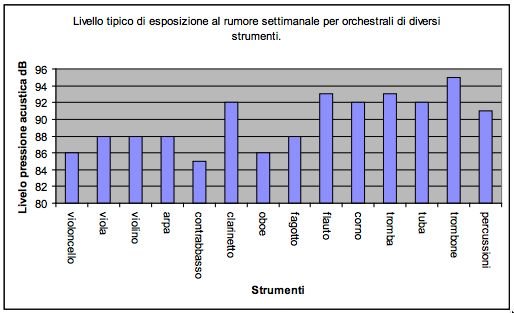
For the cymatic analysis we used instead the following equipment:
· Acoustic box we designed and built, in air suspension, capable of emitting frequencies from 20hz (point at -3db)
· Custom loudspeaker, built by an Italian manufacturer on our specifications, which can emit frequencies from 20 hz to 4 khz
· Sinusoidal function generator capable of generating waves at any frequency value
· NAD3020E amplifier (with volume set to full scale so as to use the output level control exclusively from the function generator) to which our function generator was connected as signal source and our loudspeaker as output.
Our guitar, from the bottom side, was placed on the case at a distance of about 8 cm from our loudspeaker, and rested on blocks of foam rubber suitably arranged in non vibrational areas, making sure that on the side of the bottom of the guitar the center of the speaker was right in correspondence with the bridge bone, thus simulating the forced action of the strings..
The table is vibrated by means of a loudspeaker at a specific frequency, and it is observed how the black tea powder spred on the soundboard is available would come to rest.
By changing the vibration frequency it is observed at what value the dust grains jump the most: these frequencies are referred to as table resonance frequencies.
The dust grains are arranged following precise geometries made up of nodes and antinodes: clearly the dust will tend to accumulate at the nodal points, i.e. at those points where the amplitude of the sound wave is zero. Whereas where the amplitude is maximum or minimum, the antinodes will cause the dust to be blown away.
With this method (setting: for high frequencies, from 800hz upwards, a value of the output level of our function generator equal to 100%, whilst we set all other frequencies at the level of 89%) we determined frequency response values. The maximum frequency value data at which our table still vibrates (maximum frequency determination) and the minimum frequency value data at which our table begins to go into resonance (minimum frequency determination) are reported below:

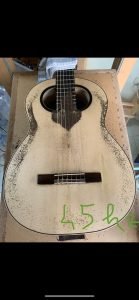
” “it is an extension in the bass range without precedent ...
the box resonance frequency (45 Hz) is very similar to the resonance frequency of a bass.
IThe acoustic result is as follows: bass sounds are always extremely rich, full-bodied and extremely deep, as well as well articulated.
In addition, unlike what occurs with instruments equipped with “Tornavoz”, in our case bass sounds, really generated by the sound box of the guitar, are characterized by an extreme cleanliness of tone and naturalness, therefore capable of maintaining unchanged the projectivity of the instrument.
Mode 5: maximum frequency attainable by a guitar in Marco Sellitto’s project
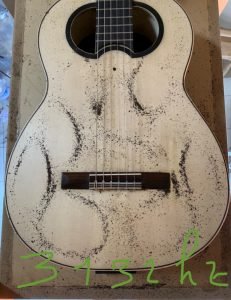
This is an extension in the high range. In this case too it is unprecedented. We are talking about a box that can reach the same maximum high frequency attainable by a violin.
.
From an acoustic point of view, this translates into a remarkable projective ability in large rooms, which allow you to perfectly hear the sound of this instrument, regardless of whether a listener is sitting in the front row or in the back row.
In addition to this great gift of projectivity, an indispensable quality or a concert performer, from the timbral point of view this extreme extension in the high range yields:
:
- - a very limpid and clean E-string, but at the same time full and rich, therefore never “weak” or shrill, but very sweet, expressive and extended
- - allowing this instrument to offer the performer such a quantity of tonal nuances as to exponentially increase “the colours” at his disposal during the interpretation. It will then enable the performer’s musical thought to pass through without curtailing it in any way, on the contrary, stimulating it even further...
In light of the results of the measured frequency responses, Table 1.a is completed and becomes:
The initial table is thus completed:

Table 1.C: table 1.a with added guitar frequency response in Marco Sellitto’s project
As far as the lowest frequency response of our sound box goes, as can be inferred from the data in the table, it generates a deep bass comparable to that of a double bass and, in terms of trebles, it is equal to that of an extended E-string, as that of a violin. As far as the total bandwidth goes, it is almost identical to that of an ensembleof string instruments.
This extension involves a greater content of higher harmonics of the various fundamental frequencies, and therefore a greater richness of timbre.
Modal Analysis
As for violins, also for the classical guitar we know that the vibrational modes, i.e. the morphological configurations, which can be visualized (either with indirect techniques such as laser, holography, or direct ones, such as tea dust), are 5[1], classified as vibration mode.
We have: mode 1; mode 2; mode 3; mode 4; mode 5, shown below:
:
[1] Jansson, Erik. (2020). ACOUSTICS FOR VIOLIN AND GUITAR MAKERS
Table 5 below shows the frequencies at which, for each instrument being tested, the modal figures attributable to modes 1-2-3-4-5 were displayed; if any of these modes has not been produced, the table will show the wording “not present”.
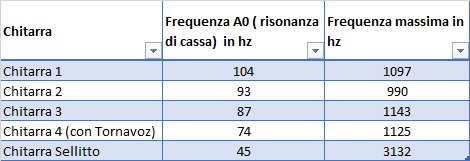
Table 5: list of resonance modes of tested guitars
[2] the most significant values, on which converge the study of radiation efficiency for classical guitars, are to be found between 150 Hz and 450 Hz (Ian Perry “Sound Radiation Measurements on guitars and other stringed musical instruments” _Cardiff University UK).
[3] Jansson “Acoustics for violin and guitar makers” _
[4] See related spectral analyses carried out in this specific area. The Sellitto guitar reveals a uniformity and an intensity of order of magnitude greater than all other 4 being tested
Initial remarks:
Mode 5: the Sellitto guitar can generate it 7 times up from 587hz to 3132 hz while all the other guitars of the test only once (i.e. at a single frequency only)
Here below are some photos taken on the modes displayed when testing the Sellitto guitar:
Some examples of MODE 1 (A0), displayed:
We have resonance of (mode 1 A0), as early as 45ha, 61hz and 70hz:
Remarks:
From the photos of the modes displayed on the soundboard, we can observe the perfect symmetry of the displayed figures, which testify to an ideal Q factor.
The number of times the various resonance modes occurred, together with the constant presence of resonance at all meaningful frequencies, yields a clear picture: harmonically rich, of high intensity and absolutely regular and uniform.
The character of the guitar and its quality factor is well highlighted and influenced by the frequency response which it produces in the range of frequencies ranging from about 150hz to about 450hz[1].
We have also made a spectral analysis whown here below (the one from guitar 4 is missing because it is part of the owner’s collection), which testifies to the absolute operational validity of the cymatic method, for the qualitative analysis of the instruments; for ease of visualization we have placed them side by side in the same graph.
For your convenience we have shown side by side the frequency response graphs of the 1-2-3-Sellitto guitars in the 150hz-450hz range:
[1] Jurger Meyer “Acoustic and the Performance of Music – The Classical Guitar”; “Dynamic Response Optimization on a Classical Guitar”, M.M.A.Von Boven.
The character of the guitar and its quality factor is well highlighted and influenced by the frequency response which it produces in the range of frequencies ranging from about 150hz to about 450hz[1].
We have also made a spectral analysis whown here below (the one from guitar 4 is missing because it is part of the owner’s collection), which testifies to the absolute operational validity of the cymatic method, for the qualitative analysis of the instruments; for ease of visualization we have placed them side by side in the same graph.
For your convenience we have shown side by side the frequency response graphs of the 1-2-3-Sellitto guitars in the 150hz-450hz range:
Note that while the frequency responses of all the guitars in the test are absolutely disarranged and irregular, the Sellitto guitar yields almost a straight line and is always completely “full”, and therefore rich in harmonics.
With these closing tests we have also demonstrated the last point, namely the absolute harmonic richness and uniformity (therefore linearity) of the Sellitto guitar’s response, compared to all the others tested.
[1] Jurger Meyer “ acoustic and the performance of music—Classical Guitar” ; “Dynamic response optimization on an classical guitar” M.M.A.Von Boven.

Comparing spectral analysis (150hz-450hz) from left to right: guitar 1 (lattice brace project) – guitar 2 (Double Top project) –guitar 3 (Hauser project) – Sellitto guitar (last one on the right)
In our examination of what are the main limitations of the classical guitar, we have seen:
FIRST LIMITATION:
Very limited bandwidth (frequency response)
The guitar designed by Marco Sellitto has a frequency response from 45 Hz to 3132 Hz, thus overcoming the limitation that has always restrained the classical guitar. The Sellitto guitar instead equals the sum of the frequency responses of a string ensemble (double bass, cello, viola, violin), taken together.
A summary table of the frequency responses of the various instruments is given below: Lorem ipsum dolor sit amet
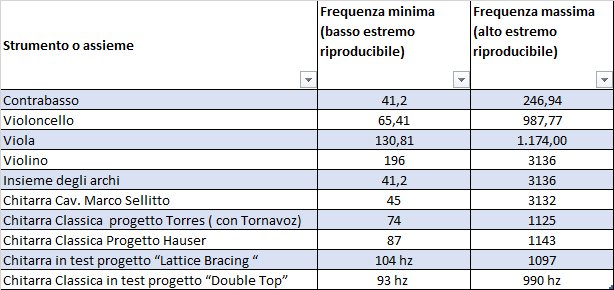
We have demonstrated the frequency response of the Marco Sellitto’s project from a quantitative point of view.
SECOND LIMITATION:
Extremely erratic frequency response (TIMBER IMBALANCE): Within a given passband it exhibits a behaviour characterised by peaks and troughs at certain frequencies.
With 3 types of tests :
I) Measuring the balance throughout the six strings
II) Cymatics test and
III) Spectrum analysis
I) a perfect balance between the db output of the 6 strings
II) a very high harmonic content
III) an extremely linear frequency response
THIRD LIMITATION:
Limited power.
Measuring the various musical instruments (e.g. viola, violin, harp, bassoon, etc.) at a distance of approx. 3.7 metres, they measure approx. 88 db on average.
Among all the projects in the test, Marco Sellitto’s guitar presents at the same distance approx. the same power (88,1 db detected at 3,7mt) against approx. 83-83,5 db detected in the other guitars.
One should bear in mind that the human ear perceives 3 db as a doubling of volume and, consequently, -3db as a halving of volume.
At a distance of 3.7 metres the guitar in Marco Sellitto’s project yields the same power as the instruments of the orchestra (viola, violin, archa, bassoon, etc), and a good 5 db more than the classical guitar tested in the other projects.
In summary, all the three main limitations of the classical guitar have been definitely resolved and overcome with the guitar in Marco Sellitto concert guitar project.
